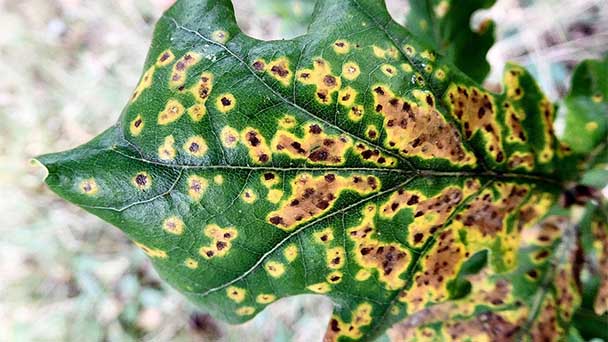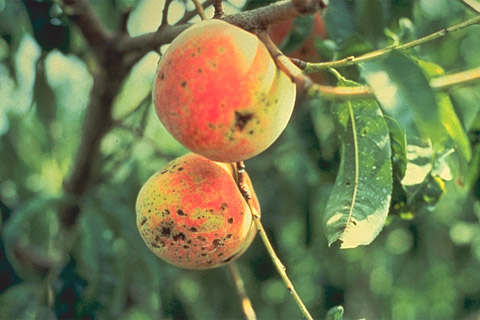Symptoms and effects of the plant diseases caused by bacteria
Written by Joy
Sep 28 2020

Pathogenic bacteria can live through the winter or summer in seeds or other propagation materials, diseased bodies, soil, manure, weed hosts or insects, and become the source of initial infection in the next growing season. Most bacterial diseases can re-infect. Generally, high temperature, rainy and humid weather are conducive to the occurrence of bacterial diseases. Bacteria invade through the host's wounds or stomata, water holes, lenticels and other natural holes; the field is mainly spread through rainwater, irrigation water, vector insects or agricultural operations. Unfavorable conditions such as typhoons and heavy rains not only easily cause wounds on the surface of plants, but also facilitate the spread of bacteria and weaken the disease resistance of host plants, and induce the epidemic of bacterial diseases. Some vectors transmit bacterial diseases with a certain degree of specialization. For example, corn bacterial wilt is transmitted by corn leaf, and wheat honey ear disease is transmitted by wheat grain nematode.

②Necrosis mainly occurs on leaves and stems, with various spots or scorches, the former such as cotton angular leaf spot and the latter such as rice bacterial blight.
③ wilting. It is caused by bacteria parasitizing in the vascular bundle to block the catheter or caused by bacterial toxins, such as bacterial wilt.
④ Tumor. Due to bacterial stimulation, host cell proliferation and tissue enlargement are formed, such as cancer
disease.
⑤ Yellowing dwarf. Bacteria parasitic in the xylem make plants yellow and shrink, such as grape Peir's disease, apricot leaf scorch, alfalfa dwarf disease, sugarcane dwarf disease and peach fruit disease, etc.

The main symptoms of bacterial diseases
① Rotting. Due to the decomposition of pectinase secreted by bacteria, the cells of the roots, stems, tubers, tubers, fruits, ears and other hypertrophy and succulent organs of the injured plants dissociate, the tissues collapse and rot, such as soft rot of cabbage.②Necrosis mainly occurs on leaves and stems, with various spots or scorches, the former such as cotton angular leaf spot and the latter such as rice bacterial blight.
③ wilting. It is caused by bacteria parasitizing in the vascular bundle to block the catheter or caused by bacterial toxins, such as bacterial wilt.
④ Tumor. Due to bacterial stimulation, host cell proliferation and tissue enlargement are formed, such as cancer
disease.
⑤ Yellowing dwarf. Bacteria parasitic in the xylem make plants yellow and shrink, such as grape Peir's disease, apricot leaf scorch, alfalfa dwarf disease, sugarcane dwarf disease and peach fruit disease, etc.
Prevention method
It a good choice to plant quarantine, establish disease-free farms, disinfect seedlings, and pay attention to field hygiene to reduce bacterial sources; you also can use disease-resistant varieties, adopt crop rotation, high-ridge planting and other disease-preventing cultivation measures to prevent and control vector insects; using bacteriophages as seeds Inspection, and strengthening the prediction of field disease epidemics is also a good method.Latest Updated
- Benefits of Bugleweed - 7 Science-backed Health Benefits
- Bugleweed Dangers & Side Effects - Is It Poisonous?
- How to Plant Evergreen Trees - What You Should Know
- When to Plant Evergreens - Grow Guide for Evergreen Trees
- 12 Wonderful Evergreen Shrubs for Your Garden
- 12 Popular Evergreen Plants with Pictures for Beginners
- When And How To Prune A Lilac Bush Like a Pro
- How to Grow & Care for Lilac Vine (Hardenbergia Violacea)
- Japanese Lilac Tree (Syringa Reticulata) Care & Propagation Guide
- Shumard Oak Pros and Cons - What to Know
Popular Articles
- Winter maintenance of Antirrhinum Majus
- How to Grow Terminalia Mantaly Tree
- How to Grow and Care for Crossostephium Chinense
- How to grow Antirrhinum Majus in spring
- Peristeria Elata (Dove Orchid) Profile: Info & Care Guide
- Underwatered Snake Plant (Sansevieria Trifasciata) - Signs And How To Fix
- How to Care for Brazilian Jasmine Plant (Mandevilla Sanderi)
- How to Grow & Care for Graptopetalum Purple Delight in Summer
- Rosa Chinensis (China Rose): Plant Growing & Care Tips
- How to Care for Baby Sun Rose (Aptenia Cordifolia)